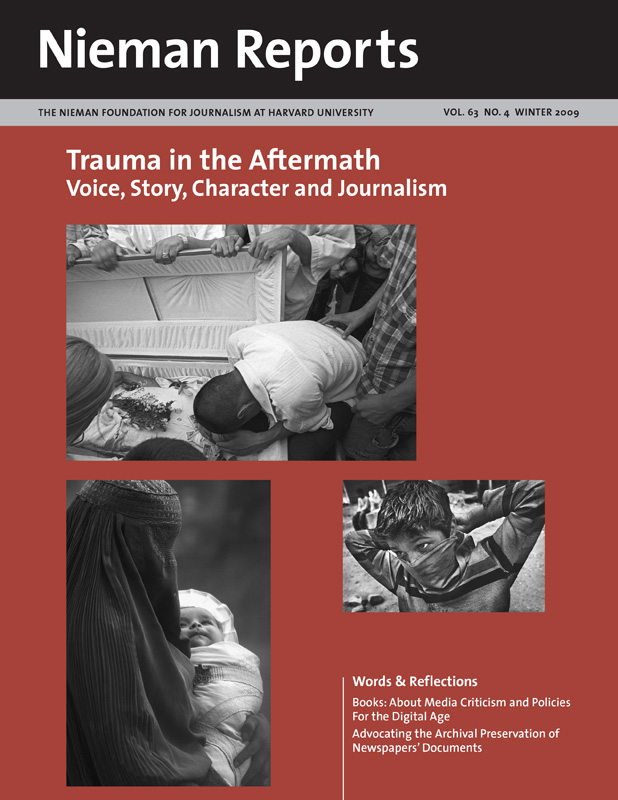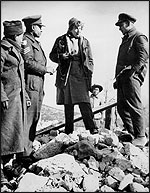“Caring about what you see may well be the key to good reporting, for it means you look closer, and you look to find out why. The much-bruited idea that we are all damaged by grim experience is countered surely by the idea that we are all changed by experience, but not necessarily for the worse.”
—Kate Adie, BBC, from her autobiography, “The Kindness of Strangers”
Reporting from a war zone is increasingly hazardous. Mortality figures for journalists covering conflict during the last century reveal that in the Great War of 1914-1918, two journalists lost their lives. In the six years of World War II, 66 died, 17 died during the Korean War, and 58 journalists were killed during the prolonged Vietnam conflict. In Iraq, the Vietnam casualties have more than doubled in a conflict that has not yet ended.
This troubling progression is not happening because Fallujah is any more dangerous than the trenches in World War I. Rather this rise reflects a fundamental change in the way that war is now fought; warring factions often regard journalists as targets.
The heightened danger and ubiquitous threat that journalists confront carries significant psychological challenges. Exposure to life-threatening events creates potential risk for conditions such as post-traumatic stress disorder (PTSD), depression and substance abuse, and journalists are not immune. Data collected from a group of 218 frontline journalists who worked in zones of conflict for 15 years, on average, revealed rates of PTSD five times higher than those found in the general population. Moreover, rates of depression and alcohol abuse in this group well exceeded those found in journalists who had spent their careers far removed from the danger of distant conflicts.
War journalists are, however, a diverse group. A close look at the data reveals that war photographers, for example, have higher rates of PTSD symptoms than print reporters or producers. And freelance journalists have more depression than peers who are employed by major news organizations.
Gender: What Role Does It Play?
While exploring such differences we wondered whether gender played any role in the development of psychological distress. To those unfamiliar with the epidemiology of psychiatric illness, that question might beg another: Why is this of interest? The answer: Many factors influence a person’s mental health and gender differences, in particular, lead to predictable variations in the rates of common psychiatric conditions.
Studies of tens of thousands of people from 17 countries demonstrate that geography is less salient than gender in this regard. Whether journalists live in the United States or Japan, Turkey or Taiwan, they are more likely to develop depression or anxiety if they are female. (This finding applies not only in times of peace.) Female civilians in war torn Kosovo, Sri Lanka, Yugoslavia, Nepal and Afghanistan also were found to have higher rates of depression and anxiety. Data collected by the U.S. military show female soldiers to be more susceptible to psychological problems than their male counterparts.
Knowing this, we turned to our database of journalists whose histories we’ve collected over the past decade. Even before probing the characteristics of their behavior, we looked carefully at demographic comparisons:
- Gender: Three quarters of these journalists are male. We weren’t surprised since there are solid neurochemical and evolutionary reasons why men are more likely to gravitate to risky environments than are women.
- Marriage: The marital data revealed unexpected findings. By the time people reach their late 30s (the average age for males and females in our sample), more women than men are usually married. This is not true with war journalists. While most of the men in our sample were married, the majority of women were single.
- Education: Female frontline journalists are better educated than their male colleagues. These findings, which we believe cannot be attributed to chance, are of clinical significance as they help frame and explain the behavioral data.
War Journalists: Habits and Health
These war journalists were questioned about PTSD, depression, general psychological distress, and weekly alcohol consumption. As with our demographic findings, what we found out went against the grain of what we knew about the general population’s gender divide. Female war journalists are not more likely than their male counterparts to develop PTSD, depression or psychological distress in general. They also drink just as much, if not more alcohol than the men when measured by the standards of what is considered healthy drinking. Medical orthodoxy dictates that women, by virtue of their smaller body mass and smaller livers (the main site of alcohol metabolism) should drink no more than nine units of alcohol per week. The upper limit for men is 14 units, with a unit defined as a shot of spirits, bottle of beer, or glass of wine. With these thresholds in mind, the percentage of women and men frontline journalists exceeding them is 21 percent and 24 percent, respectively.
While this gender difference is not statistically significant, what stands out is its contrast between the general population and the habits of war journalists. Men, generally, are two to three times more likely than women to drink to excess. There is an important caveat that goes along with the findings; the absence of gender differences in the war journalists’ alcohol consumption should not be misconstrued as indicating an absence of emotional problems among the women. Rates of distress are high in both groups. Rather, it is the gender parity that is remarkable.
How do we explain these intriguing results? Here we enter the realm of hypotheses since our studies have been primarily descriptive. We’ve not yet probed cause and effect. However, the emerging profile of the female war journalist—more likely to be single and better educated than their male colleagues, no more vulnerable to PTSD, depression or overall psychological distress, and keeping up with the men when it comes to drinking—suggests they are a highly select group. It is not by chance that these women have gravitated to the frontlines of war.
Undoubtedly there are good biological reasons for this. Dopamine, a neurotransmitter, and testosterone, a hormone, are two biochemical markers under tight genetic control. And each has been linked to the more adventurous life. This does not imply that war journalists are primarily motivated by risk or a desire for new experiences, but there can be little doubt that the predicable nine-to-five daily grind that characterizes so many job descriptions is not a lifestyle they are likely to embrace. So in trying to understand what we are seeing, we cannot minimize the role of genes and biology.
The facts, figures and statistics tell a compelling story. And so do the women journalists. Unwilling to let the data speak on its own, we’ve read the memoirs, interviews and biographies of many female war journalists. From these, we have culled anecdotes and opinions that complement the dry precision of the data. In bearing witness to war, these Cassandras, to use journalist Martha Gellhorn’s memorable self-depiction, have had many harrowing experiences. While our data reveal no gender differences in frequency of exposure to grave danger, percentages, on their own, will never fully describe the experiences these women have. In their lives and outlook there seems to be woven an intrepid insouciance that overlays a seriousness of purpose driving and sustaining many of them.
To illuminate this, we turn to war correspondent Marie Colvin writing in The Sunday Times of London about her near death experience reporting on the Tamil Tigers in Sri Lanka:
I am not going to hang up my flak jacket as a result of this incident. I have been flown to New York where doctors are going to operate on my injured eye in about a week or two. They have told me it is unlikely I will regain much use of it as a piece of shrapnel went straight through the middle. All I can hope for is a bit of peripheral vision. Friends have been telephoning to point out how many famous people are blind in one eye. They seem to do fine with only one eye, so I am not worried. But what I want most as soon as I get out of hospital, is a vodka martini and a cigarette.
In an equally blunt assessment of the risks she took in her reporting, and in response to some who called her “stupid” for taking such risks, Colvin wrote:
So, was I stupid? Stupid I would feel writing a column about the dinner party I went to last night. Equally, I’d rather be in that middle ground between a desk job and getting shot, no offence to desk jobs.
…For my part, the next war I cover, I’ll be more awed than ever by the quiet bravery of civilians who endure far more than I ever will. They must stay where they are; I can come home to London.
What we’ve discovered in the data and learned from these women’s words reminds us of the work that lies ahead as we dig deeper and search more widely for clues that can help us explain our intriguing results.
Anthony Feinstein is professor of psychiatry at the University of Toronto and author of “Journalists Under Fire: The Psychological Hazards of Covering War.” Mark Sinyor is a third-year resident in psychiatry at the University of Toronto.



